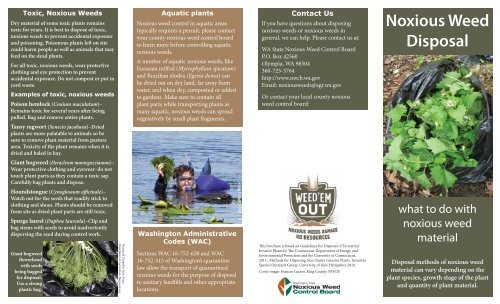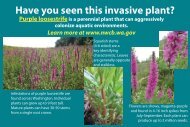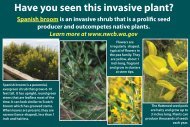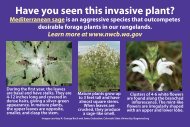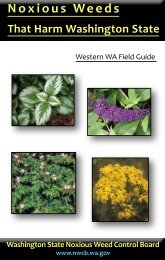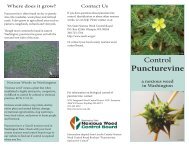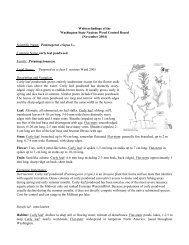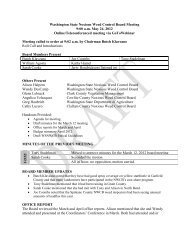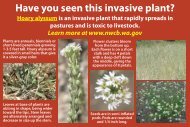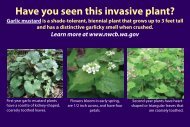Check out our new brochure on noxious weed disposal.
Check out our new brochure on noxious weed disposal.
Check out our new brochure on noxious weed disposal.
- No tags were found...
You also want an ePaper? Increase the reach of your titles
YUMPU automatically turns print PDFs into web optimized ePapers that Google loves.
Toxic, Noxious WeedsDry material of some toxic plants remainstoxic for years. It is best to dispose of toxic,<strong>noxious</strong> <strong>weed</strong>s to prevent accidental exposureand pois<strong>on</strong>ing. Pois<strong>on</strong>ous plants left <strong>on</strong> sitecould harm people as well as animals that mayfeed <strong>on</strong> the dead plants.For all toxic, <strong>noxious</strong> <strong>weed</strong>s, wear protectiveclothing and eye protecti<strong>on</strong> to preventaccidental exposure. Do not compost or put inyard waste.Examples of toxic, <strong>noxious</strong> <strong>weed</strong>sPois<strong>on</strong> hemlock (C<strong>on</strong>ium maculatum)–Remains toxic for several years after beingpulled. Bag and remove entire plants.Tansy ragwort (Senecio jacobaea)–Driedplants are more palatable to animals so besure to remove plant material from pasturearea. Toxicity of the plant remains when it isdried and baled in hay.Giant hog<strong>weed</strong> (Heracleum mantegazzianum)–Wear protective clothing and eyewear–do nottouch plant parts as they c<strong>on</strong>tain a toxic sap.Carefully bag plants and dispose.Houndst<strong>on</strong>gue (Cynoglossum officinale)–Watch <str<strong>on</strong>g>out</str<strong>on</strong>g> for the seeds that readily stick toclothing and shoes. Plants should be removedfrom site as dried plant parts are still toxic.Spurge laurel (Daphne laureola)–Clip andbag stems with seeds to avoid inadvertentlydispersing the seed during c<strong>on</strong>trol work.Aquatic plantsNoxious <strong>weed</strong> c<strong>on</strong>trol in aquatic areastypically requires a permit, please c<strong>on</strong>tacty<str<strong>on</strong>g>our</str<strong>on</strong>g> county <strong>noxious</strong> <strong>weed</strong> c<strong>on</strong>trol boardto learn more before c<strong>on</strong>trolling aquatic<strong>noxious</strong> <strong>weed</strong>s.A number of aquatic <strong>noxious</strong> <strong>weed</strong>s, likeEurasian milfoil (Myriophyllum spicatum)and Brazilian elodea (Egeria densa) canbe dried <str<strong>on</strong>g>out</str<strong>on</strong>g> <strong>on</strong> dry land, far away fromwater, and when dry, composted or addedto gardens. Make sure to c<strong>on</strong>tain allplant parts while transporting plants asmany aquatic, <strong>noxious</strong> <strong>weed</strong>s can spreadvegetatively by small plant fragments.C<strong>on</strong>tact UsIf you have questi<strong>on</strong>s ab<str<strong>on</strong>g>out</str<strong>on</strong>g> disposing<strong>noxious</strong> <strong>weed</strong>s or <strong>noxious</strong> <strong>weed</strong>s ingeneral, we can help. Please c<strong>on</strong>tact us at:WA State Noxious Weed C<strong>on</strong>trol BoardP.O. Box 42560Olympia, WA 98504360-725-5764http://www.nwcb.wa.govEmail: <strong>noxious</strong><strong>weed</strong>s@agr.wa.govOr c<strong>on</strong>tact y<str<strong>on</strong>g>our</str<strong>on</strong>g> local county <strong>noxious</strong><strong>weed</strong> c<strong>on</strong>trol board:Noxious WeedDisposalGiant hog<strong>weed</strong>flowerheadwith seedsbeing baggedfor <strong>disposal</strong>.Use a str<strong>on</strong>gplastic bag.Thomas B. Denholm, New JerseyDepartment of Agriculture, Bugwood.orgWashingt<strong>on</strong> AdministrativeCodes (WAC)Secti<strong>on</strong>s WAC 16-752-620 and WAC16-752-515 of Washingt<strong>on</strong>’s quarantinelaw allow the transport of quarantined<strong>noxious</strong> <strong>weed</strong>s for the purpose of <strong>disposal</strong>to sanitary landfills and other appropriatelocati<strong>on</strong>s.King County NWCBThis <str<strong>on</strong>g>brochure</str<strong>on</strong>g> is based <strong>on</strong> Guidelines for Disposal of TerrestrialInvasive Plants by The C<strong>on</strong>necticut Department of Energy andEnvir<strong>on</strong>mental Protecti<strong>on</strong> and the University of C<strong>on</strong>necticut,2011; Methods for Disposing N<strong>on</strong>-Native Invasive Plants, InvasivesSpecies Outreach Group, University of New Hampshire 2010.Cover image: Frances Lucero, King County NWCBwhat to do with<strong>noxious</strong> <strong>weed</strong>materialDisposal methods of <strong>noxious</strong> <strong>weed</strong>material can vary depending <strong>on</strong> theplant species, growth stage of the plantand quantity of plant material.
Disposing <strong>noxious</strong> <strong>weed</strong>materialC<strong>on</strong>trolling<strong>noxious</strong> <strong>weed</strong>scan generatesmall to largeamounts ofplant material.Properlymanaging andhandling this material, as well as soil thatmay c<strong>on</strong>tain roots or seeds, will help preventthe spread and reestablishment of these<strong>noxious</strong> <strong>weed</strong>s. C<strong>on</strong>duct as much <strong>noxious</strong><strong>weed</strong> c<strong>on</strong>trol as possible before plants flowerand develop seed. Also, by c<strong>on</strong>trolling<strong>noxious</strong> <strong>weed</strong>s earlier in the seas<strong>on</strong>, beforethey are finished growing, there will be lessplant material to manage.For questi<strong>on</strong>s ab<str<strong>on</strong>g>out</str<strong>on</strong>g> <strong>disposal</strong> and c<strong>on</strong>trolopti<strong>on</strong>s, c<strong>on</strong>tact y<str<strong>on</strong>g>our</str<strong>on</strong>g> county <strong>noxious</strong> <strong>weed</strong>c<strong>on</strong>trol board for informati<strong>on</strong> and assistancethat is specific to y<str<strong>on</strong>g>our</str<strong>on</strong>g> county. Somecounties have specific <strong>disposal</strong> requirementsor provide financial assistance to residentsdisposing their <strong>noxious</strong> <strong>weed</strong>s.General TechniquesIf plants are flowering, cut and bag flowerswhen possible to prevent seed developmentand dispersal. Seal bags and put them inthe trash. Noxious <strong>weed</strong>s that are treatedwith herbicide may be left in place withsome excepti<strong>on</strong>s (see toxic, <strong>noxious</strong> <strong>weed</strong>informati<strong>on</strong>).Woody and Herbaceous Material:Small amounts of woody plant materialthat do not have seeds and do not spreadvegetatively, can be c<strong>on</strong>trolled by pulling orcutting plants and leaving them <strong>on</strong> site withroots exposed to dry, making a brush pile,chipping or burning. If seeds are present,leave <strong>on</strong> site and pile and cover with a tarp orburn, and m<strong>on</strong>itor the area for <str<strong>on</strong>g>new</str<strong>on</strong>g> plants.For small amounts of herbaceous materialsthat do not have seeds and do not spreadvegetatively, plants can be composted, pulledand bagged, pulledor cut and left <strong>on</strong>site to dry with rootsexposed (as l<strong>on</strong>g asplants are not toxic).For large amounts of material with<str<strong>on</strong>g>out</str<strong>on</strong>g> seeds,pull or cut plants then pile, tarp and m<strong>on</strong>itorthe area for any re-spr<str<strong>on</strong>g>out</str<strong>on</strong>g>ing material.Drying: Plant parts with<str<strong>on</strong>g>out</str<strong>on</strong>g> flowers or seedsthat will not spread vegetatively, can be left<strong>on</strong> the ground and m<strong>on</strong>itored as they dry <str<strong>on</strong>g>out</str<strong>on</strong>g>.Plant parts that d<strong>on</strong>’t have flowers or seeds butmay still spread vegetatively should be left <strong>on</strong>tarps, pavement or other surfaces that preventthem from taking root in the soil.Pile and Tarp: For large amounts, pile plantmaterial <strong>on</strong> sheet of plastic or tarp andsecurely cover with another tarp to preventlight and water from reaching plant parts andto keep plant parts c<strong>on</strong>tained. Leave plantstarped until material is completely dried <str<strong>on</strong>g>out</str<strong>on</strong>g>.Bag and Trash: For toxic plants and smallinfestati<strong>on</strong>s of <strong>noxious</strong> <strong>weed</strong>s, the entire plantcan be removed and sealed into a plastictrash bag and disposed. When possible, allowbagged plants to rot in a sunny locati<strong>on</strong>, thendispose of in regular trash.Municipal Yard Waste: Some city compostfacilities may be hot enough to kill <strong>noxious</strong><strong>weed</strong> material. C<strong>on</strong>tact y<str<strong>on</strong>g>our</str<strong>on</strong>g> local county<strong>noxious</strong> <strong>weed</strong> c<strong>on</strong>trol board or wastemanagement to see if this opti<strong>on</strong> is available.When moving <strong>noxious</strong> <strong>weed</strong>s in a vehiclefor <strong>disposal</strong>, make sure to secure plantmaterial so n<strong>on</strong>e can escape duringtransport. Clean the vehicle and equipmentof any <strong>noxious</strong> <strong>weed</strong>material to preventthe spread of seedsand vegetative parts.Also remember toclean y<str<strong>on</strong>g>our</str<strong>on</strong>g> shoes andclothing of any seeds,plant parts and soilthat may c<strong>on</strong>tain <strong>noxious</strong> <strong>weed</strong> seed andpropagating plant parts.Chipping and Compost: Woody plantsthat do not spread vegetatively can bechipped and left <strong>on</strong> site to compost. Chipbefore plants flower and develop seed.Burning: May be an opti<strong>on</strong>, especially forlarge amounts of plant material. However,burn <strong>on</strong>ly in accordance with all federal,state, and local laws and ordinances andpermits. M<strong>on</strong>itor weather c<strong>on</strong>diti<strong>on</strong>s priorto igniti<strong>on</strong> to avoid hazardous fires. It isnot advisable to burn some plants, such astoxic plants.Thurst<strong>on</strong> County NWCBComposting at HomeMost home compost piles do not get hotenough to kill seeds or plants, so <strong>on</strong>ly add<strong>noxious</strong> <strong>weed</strong>s that do not have flowersor seeds and do not spread vegetatively.Do not home compost toxic plants. Anumber of <str<strong>on</strong>g>our</str<strong>on</strong>g> <strong>noxious</strong> <strong>weed</strong>s can spreadvegetatively by plant fragments. Forexample, roots, stems and leaf parts ofthese species can develop roots and spr<str<strong>on</strong>g>out</str<strong>on</strong>g><str<strong>on</strong>g>new</str<strong>on</strong>g> plants, which can escape compost pilesas well as illegal dump sites and spread int<strong>on</strong>atural areas. Do not put these <strong>noxious</strong> <strong>weed</strong>sin home compost piles. Periodically m<strong>on</strong>itory<str<strong>on</strong>g>our</str<strong>on</strong>g> compost area for any escaping <strong>weed</strong>s.Examples of vegetatively spreading <strong>noxious</strong><strong>weed</strong>s: yellow archangel (Lamiastrumgaleobdol<strong>on</strong>), purple loosestrife (Lythrumsalicaria) yellow iris (Iris pseudacorus),knot<strong>weed</strong>s: Japanese, Bohemian, giant andHimalayan, (Polyg<strong>on</strong>um cuspidatum, P. xbohemicum, P. sachalinense, P. polystachyum)and f<str<strong>on</strong>g>our</str<strong>on</strong>g> selecti<strong>on</strong>s of English ivy (Hederahelix ‘Baltica’, Hedera helix ‘Pittsburgh,and Hedera helix ‘Star’; Hedera hibernica‘Hibernica’).Yellow archangel growing in a natural areafrom illegal yard waste dumping. Cut stemscan form roots at the leaf nodes and quicklygrow and take over a <str<strong>on</strong>g>new</str<strong>on</strong>g> area.


